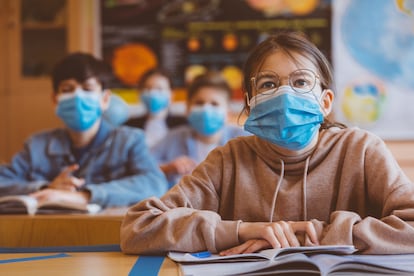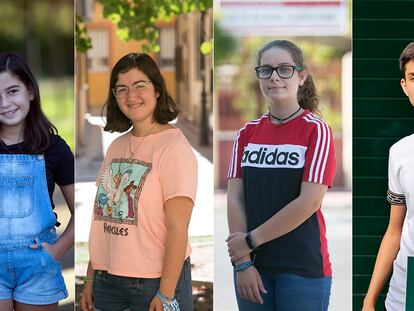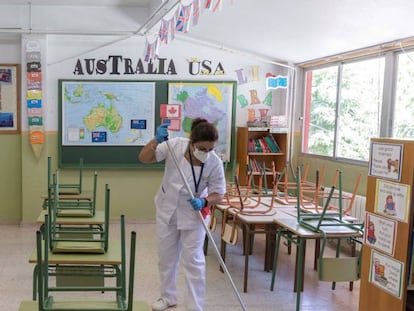Why have Spain’s schools not turned into coronavirus hotspots?
Fears that reopening centers would lead to large outbreaks have failed to materialize with only 1.5% of classes in the country quarantined. EL PAÍS talked to experts to find out why

“As soon as school returns, we’ll all be confined again within two weeks.” That was the common refrain among neighbors, work colleagues and parents in Spain as the country gradually lifted its strict coronavirus restrictions. Many were scared, understandably so, that reopening schools would lead to new coronavirus outbreaks and restrictions. Fortunately, schools in Spain are instead resisting the spread of the disease. That’s the conclusion, with some nuances, that health experts have come to after reviewing the Education Ministry’s figures from the first week of November. At that time, Spain was recording a steep rise in coronavirus cases, yet only 6,469 classes were in quarantine, or 1.67% of the total number of classes in Spain’s education system.
So how have schools been able to contain the virus? Why are they not at the center of a second wave of cases? Especially given that they are enclosed spaces, filled with children and teenagers who study, play and even eat together.
Other experts believe there may be another reason why the coronavirus incidence rate in schools is relatively so low: children have a much higher likelihood of being asymptomatic than adults
“There are two reasons,” says the pediatrician and epidemiologist Quique Bassat. “The first is that children spread the virus less effectively than adults. The data we have from the last nine months suggests that children are very rarely the source of outbreaks. In Catalonia, for example, in 87% of the cases detected in schools, the positive cases have not led to a second infection.”
Bassat, who was also the coordinator of the Spanish Pediatrics Association’s working group for the reopening of schools, says that there is growing evidence that backs this theory. For example, a research project from the Kids Corona platform that tracked more than 2,000 youngsters and camp counselors at summer camps in Barcelona found that contagion rates among children were six times lower than they were among the general population.
Children were feared to be at high risk during the first few months of the coronavirus pandemic and experts say this was why there was such hesitancy surrounding reopening schools. “The logic that made us think that children are infected more is because their natural history is of getting infected with multiple respiratory viruses, especially during their early years. But, fortunately, with the coronavirus this hasn’t happened,” says Julián Olalla, an internist and the head of the scientific committee of the first National Covid-19 Congress, which took place in September. “As of today, it is thought not only that the infection is less serious in them [children] but also that transmission is less effective.”
Olalla, however, says that this does not explain the situation in Spain’s schools: although children are infected less than the general population, they still can spread the virus. He believes the main reason schools have not turned into coronavirus hotspots is due to the strict protocol in education centers aimed at reducing contagions, such as class “bubbles,” separate entrances and exits, social distancing and screens. “What schools have shown is that it is possible to contain the virus even in an environment that appears to be adverse and which for several hours acts as an enclosed center,” he says, adding that this feat has been achieved thanks to the efforts of Spain’s teaching community. “We have to recognize that educators, without being health workers, have been on the frontline and without mass sick leaves,” says Olalla.
Too soon to let guard down
Does that mean we can breathe easily and trust that, if the rules continue to be observed, the situation in schools will remain under control?
According to Daniel López Acuña, the former general secretary of the Health Ministry and a professor at the Andalusian School of Public Health, the answer is a firm no. “By themselves, schools are not an infection hotspot, but they do widen transmission,” he warns. “As long as we have high incidence rates, schools will have more outbreaks and more transmission because people gather there, it’s a phenomenon as simple as that.” López Acuña argues that while it is important for schools to have measures to prevent contagions, it is “equally important” for there to be broader restrictions aimed at lowering the incidence rate.
The health expert adds that – based on Health Ministry data published on November 6 – education centers are the third-highest cause of coronavirus outbreaks. According to this particular ranking, social gatherings with family and friends cause the highest number of outbreaks, accounting for 26% of the total. Social services centers, principally senior residences, come in second place, causing 22% of all outbreaks. Education centers, which include schools and universities, account for 12%.
“We have to see how many of these outbreaks occurred in primary education centers, how many in high schools and how many in universities, because evidently there is a greater problem in universities and high schools. But we cannot confirm that there are no outbreaks in primary schools,” says López Acuña. “Although effectively these centers are not the main hotspot of contagion, we can’t underestimate them. That means strictly following the preventive measures and trying to stop [cases] from happening in small groups, among friends or when coming and going from school in groups and without protection.”
Other experts believe there may be another reason why the coronavirus incidence rate in schools is relatively so low: children have a much higher likelihood of being asymptomatic than adults. That’s according to several studies, including one published last August in The British Medical Journal. This may indicate that not all coronavirus cases in schools are being counted because students are not presenting symptoms. Sergio Alonso, a researcher of the Computational Biology and Complex Systems group at the Polytechnical University of Catalonia. “Right now, the distribution of the incidence rate by age group shows that cases among children [in the zero to nine and 10 to 19 age brackets] are being detected slightly less than adults,” explains Alonso. “This is due to the fact that they tend to be asymptomatic, meaning there is a greater possibility that they are not being detected.”
English version by Melissa Kitson.
Tu suscripción se está usando en otro dispositivo
¿Quieres añadir otro usuario a tu suscripción?
Si continúas leyendo en este dispositivo, no se podrá leer en el otro.
FlechaTu suscripción se está usando en otro dispositivo y solo puedes acceder a EL PAÍS desde un dispositivo a la vez.
Si quieres compartir tu cuenta, cambia tu suscripción a la modalidad Premium, así podrás añadir otro usuario. Cada uno accederá con su propia cuenta de email, lo que os permitirá personalizar vuestra experiencia en EL PAÍS.
¿Tienes una suscripción de empresa? Accede aquí para contratar más cuentas.
En el caso de no saber quién está usando tu cuenta, te recomendamos cambiar tu contraseña aquí.
Si decides continuar compartiendo tu cuenta, este mensaje se mostrará en tu dispositivo y en el de la otra persona que está usando tu cuenta de forma indefinida, afectando a tu experiencia de lectura. Puedes consultar aquí los términos y condiciones de la suscripción digital.
More information
Últimas noticias
Most viewed
- Sinaloa Cartel war is taking its toll on Los Chapitos
- Oona Chaplin: ‘I told James Cameron that I was living in a treehouse and starting a permaculture project with a friend’
- Reinhard Genzel, Nobel laureate in physics: ‘One-minute videos will never give you the truth’
- Why the price of coffee has skyrocketed: from Brazilian plantations to specialty coffee houses
- Silver prices are going crazy: This is what’s fueling the rally










































